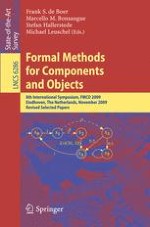All modern industries rely on large and complex software systems. In order to construct such large systems in a systematic manner, the focus of the development methodologies has switched in the last two decades from functional to structural issues. Formal methods have been applied successfully to the verification of medium-sized programs in protocol and hardware design. However, their application to the development of large systems requires a greater emphasis on specification, modeling, and validation techniques supporting the concepts of reusability and modifiability, and their implementation in new extensions of existing programming languages like Java. This state-of-the-art survey presents the outcome of the 8th Symposium on Formal Methods for Components and Objects, held in Eindhoven, The Netherlands, in November 2009. The volume contains 17 revised contributions submitted after the symposium by speakers from each of the following European IST projects: the IST-FP6 project BIONETS on biologically inspired services evolution for the pervasive age; the IST-FP7 project COMPAS on compliance-driven models, languages, and architectures for services; the IST-FP6 project CREDO on modelling and analysis of evolutionary structures for distributed services; the IST-FP7 DEPLOY on industrial deployment of advanced system engineering methods for high productivity and dependability; the IST-FP7 project HATS on highly adaptable and trustworthy software using formal methods; the IST-FP7 project INESS on integrated European railway signalling system; the IST-FP7 project MOGENTES on model-based generation of tests for dependable embedded systems; the IST-FP6 project PROTEST on property based testing; and the IST-FP7 project QUASIMODO on quantitative system properties in model-driven-design of embedded systems.
